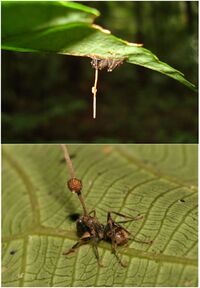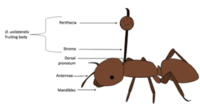Ophiocordyceps unilateralis
| Kingdom: | Fungi |
|---|---|
| Division: | Ascomycota |
| Class: | Sordariomycetes |
| Order: | Hypocreales |
| Family: | Ophiocordycipitaceae |
| Genus: | Ophiocordyceps |
| Species: | O. unilateralis |
Ophiocordyceps unilateralis
 Commonly known as the zombie-ant fungus, Ophiocordyceps unilateralism is an insect-pathogenic fungus that was first discovered in 1859 by British naturalist Alfred Russel Wallace. O. unilateralis typically infects a specific ant host species called Camponotus leonardi but has been known to parasitize ants of other closesly related species to a lesser degree of effectiveness in terms of reproductive success and manipulation. Once infected, hosts are controlled to leave their nests in the tree canopy for environmental conditions more suitable for fungal growth. Upon reaching an area with ideal humidity and temperature conditions, the host uses their mandibles to lock on to a major vein on the underside of a leaf where they remain to die. [1] This process may take up to 10 days ultimately ending with the fungal reproductive stage where a fruiting body is created to produce more spores to infect future hosts.
Commonly known as the zombie-ant fungus, Ophiocordyceps unilateralism is an insect-pathogenic fungus that was first discovered in 1859 by British naturalist Alfred Russel Wallace. O. unilateralis typically infects a specific ant host species called Camponotus leonardi but has been known to parasitize ants of other closesly related species to a lesser degree of effectiveness in terms of reproductive success and manipulation. Once infected, hosts are controlled to leave their nests in the tree canopy for environmental conditions more suitable for fungal growth. Upon reaching an area with ideal humidity and temperature conditions, the host uses their mandibles to lock on to a major vein on the underside of a leaf where they remain to die. [1] This process may take up to 10 days ultimately ending with the fungal reproductive stage where a fruiting body is created to produce more spores to infect future hosts.
Description

Habitat and Range
Ophiocordyceps unilateralis is considered pantropical as it mainly exists in tropical forest ecosystems located in Australia, Brazil, and Thailand. However, there have been recent discoveries of this fungus also existing in warm-temperate ecosystems such as the temperate forests found in Florida, South Carolina, and Japan. [4]
Host Impact

Behavior & Reproduction
References
[1] Mongkolsamrit S, Kobmoo N, Tasanathai K, Khonsanit A, Noisripoom W, Srikitikulchai P, et al. (November 2012). "Life cycle, host range and temporal variation of Ophiocordyceps unilateralis/Hirsutella formicarum on Formicine ants". Journal of Invertebrate Pathology. 111 (3): 217–24.
[2] Evans HC, Elliot SL, Hughes DP (March 2011). "Hidden diversity behind the zombie-ant fungus Ophiocordyceps unilateralis: four new species described from carpenter ants in Minas Gerais, Brazil". PLOS ONE. 6 (3): e17024.
[3] de Bekker C, Quevillon LE, Smith PB, Fleming KR, Ghosh D, Patterson AD, Hughes DP (August 2014). "Species-specific ant brain manipulation by a specialized fungal parasite". BMC Evolutionary Biology. 14 (1): 166
[4] Araújo JP, Evans HC, Kepler R, Hughes DP (June 2018). "Ophiocordyceps. I. Myrmecophilous hirsutelloid species". Studies in Mycology. 90: 119–160.